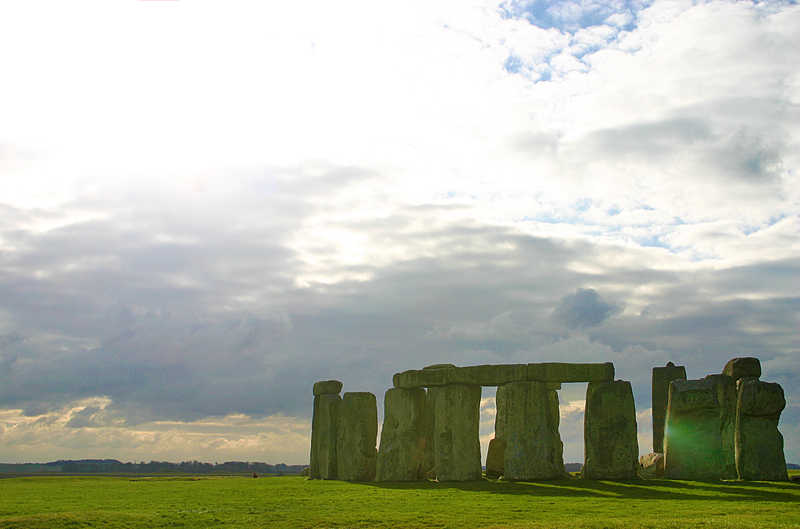National parks play a crucial role in preserving the indigenous natural attributes of a country prior to its colonization and industrialization — and the United Kingdom celebrates 70 years this year since the first national park was established in England.
Celebrating 70 Years of National Parks in the United Kingdom
The 1949 National Parks and Access to the Countryside Act created the framework for the fifteen national parks which focused on conservation, the creation and maintenance of public paths, and “preserving and enhancing natural beauty.”
This article from OnStride Financial pays tribute to these national treasures by showing some of their most beloved landscapes in a way which has purportedly never been seen before: by having created a series of voxel — or volumetric pixel — posters which bring together the most iconic areas from the national parks of the United Kingdom in order to give a modern look to these timeless areas of beauty.
I have been given express written permission to use the images and the verbatim text from the aforementioned article in this article; so let us take a break from the news of the day and have a little fun learning more about each of these national parks.
1. The Broads — Norfolk and Suffolk, England
Established as a national park in 1949, The Broads has been cultivated by human hands since the 12th century when locals dug peat pits for fuel. These trenches slowly filled with water, creating a network of navigable waterways. Long before that, 3rd-century Romans built a shore fort, Burgh Castle, whose turret and walls can still be seen today.
To the castle’s right in our poster, is Britain’s only independent lighthouse. Happisburgh Lighthouse faced closure in the 1980s but was saved due to its public popularity. Horsey Windpump, on the left, has led a short but tempestuous existence since its construction in 1912, surviving a lightning strike among other extreme weather conditions.

2. North York Moors — Yorkshire, England
Rievaulx Abbey takes centre stage in our tribute to North York Moors. The ruins of this once-influential 12th-century Cistercian monastery offer a ghostly hint of the community that once thrived here. The monks made a big success of sheep farming, lead mining, and other commercial interests. “Everywhere peace, everywhere serenity,” wrote St Aelred of monastery’s location, “and a marvellous freedom from the tumult of the world.”
Perhaps the monks occasionally walked a route like today’s Cleveland Way trail, which leads past the Abbey and up across Roseberry Topping hill. The hill is nicknamed the “Yorkshire Matterhorn” because its conical shape reminds people of the famous Swiss mountain.

3. Northumberland National Park — Northumberland, England
The UK’s most northerly national park is best known for Hadrian’s Wall. This 73-mile boundary was completed in AD128 with the purpose of keeping the ‘barbarians’ out of Roman Britain. Some mistake the wall for the border between England and Scotland. But in fact, the border is marked by the Cheviot Hills fifty miles further north, also featured on our poster.
Near the wall you’ll spot the Sycamore Gap tree, the most photographed spot in the park, and one of the most famous trees in the country. The sycamore made a cinematic appearance in Robin Hood: Prince of Thieves in 1991, although it is arguably more famous for escaping destruction when celebrity gardener Alan Titchmarsh’s helicopter narrowly missed it in a 2003 helicopter crash.

4. Cairngorms National Park — Highlands, Scotland
The UK’s largest national park covers twice the area of the Lake District. Five of Scotland’s six highest mountains can be found here, with 52 summits that exceed 900 metres (2,950 feet). The twin arches in our voxel poster are Carrbridge (in the foreground) and Linn o’ Dee.
Carrbridge was built in 1717 to allow funeral processions to cross the River Dulnain to Duthil Church when the water was high. Linn o’Dee, which bridges a narrow gorge on the River Dee, was one of Queen Victoria’s favourite spots to indulge in tea and cake.

5. Loch Lomond and the Trossachs National Park — Stirlingshire, Scotland
The fairytale-like 18th-century Inveraray Castle is a good starting point for a tour of this region of the Highlands. Most recently celebrated for its role in Downton Abbey, this Gothic Revival country house featured in the works of Sir Walter Scott and Robert Louis Stevenson.
The waterfall is the Falls of Falloch, a highlight of West Highland Way – Scotland’s most popular walking trail. Other unmissable features of the trail include the cave that local hero Rob Roy used as a hideout and the crofting ruins at Pollochro.

6. Lake District National Park — Cumbria, England
The Lake District is perhaps the UK’s best-known national park, not least due to its links to William Wordsworth and Beatrix Potter. But the area’s history runs deeper still. For example, The Castlerigg Stone Circle is one of Britain’s oldest stone circles, dating back 5,000 years to the Neolithic period.
Aira Force is a 21 metre (70-foot) waterfall amidst a deliberately landscaped Victorian park. “Not a breath of air/Ruffles the bosom of this leafy glen,” wrote Wordsworth of the hundreds of thousands of native and ornamental trees that shelter this idyllic hideaway.

7. Yorkshire Dales National Park — Yorkshire, England
The Yorkshire Dales National Park is a rugged landscape of hay meadows, drystone walls, barns and quaint villages set among the deep valleys (the ‘dales’) of North Yorkshire. The curving limestone cliffs of Malham Cove once featured a massive waterfall. Today their signature feature is a rare pair of nesting peregrine falcons.
Ribblehead Viaduct offers a human-made spectacle, especially when observed at sunset. The viaduct’s two dozen 31 metre (104-foot) arches are an incredible feat of engineering. Bolton Abbey, in the foreground of our poster, is a ruined priory that’s now a popular site for plays, picnics, and historical research.

8. Peak District National Park — Derbyshire, England
The UK’s first national park boasts a dramatic variety of dashing plateaus, from the gusty moorlands of Dark Peak to the idyllic rivers and valleys of the White Peak. On Derwent Edge the Salt Cellar, an odd-shaped gritstone tor, offers the perfect opportunity to stop and grab a selfie.
Nature has been tamed at Chatsworth House. This photogenic stately home overlooks an arboretum, maze, and the award-winning, 300-year-old Cascade: a stone staircase waterfall fed from a pond and fountains up above.

9. Snowdonia National Park — Gwynedd and Conwy, Wales
Snowdonia National Park is home to nine mountain ranges, including Mount Snowdon – the highest mountain in Wales at 1085 metres (3560 feet). But its most unique attraction is the toytown-like village of Portmeirion. Developed in the mid-twentieth century to perfectly fit into its natural setting, Portmeirion is most famous for doubling as ‘the Village’ in cult 1960s show The Prisoner.
Caernarfon Castle is a World Heritage-status fortress built by King Edward I. It is notable for its polygonal towers and colour-coded stonework. Meanwhile, Electric Mountain is a curious blend of the natural and the human-made. It’s a pumped-storage hydroelectric power station set deep within Elidir Fawr mountain that would make a great hideout for a Bond villain.

10. Pembrokeshire Coast National Park — Pembrokeshire, Wales
The Pembrokeshire Coast is all about the geology. Rugged cliffs and rock formations look down on long, sandy beaches. Stack Rocks, for instance, is a pair of limestone pillars that once formed an arch in the sea. This dignified formation is brought to life in the spring by nesting razorbills and guillemots.
Barafundle Bay is the most stunning of the park’s many beaches, and one of the most secluded. Reached after a half mile walk, the glistening sand is lapped at by crystal clear waters. The bay also offers a full view of Caldey Island, an ancient holy place off the south coast.

11. Brecon Beacons National Park — Powys, Monmouthshire, Carmarthenshire, Wales
The Brecon Beacons are a stargazer’s dream. “On a clear night you can see just about everything from anywhere,” according to Ordnance Survey – who list the park as one of the five top protected skies in Britain. In fact, it was the first International Dark Sky Reserve in Wales.
Sgwd yr Eira, the ‘fall of snow,’ is a waterfall behind which you can walk or rest, listening to it thunder down as the spray cools your face. And the Llangattock Escarpment is a peculiar arrangement of abandoned spoil heaps from centuries-old mining operations, which have now grown over with vegetation.

12. Exmoor National Park — Somerset, England
The former royal forest and hunting ground of Exmoor is a lofty park of hilly moorland underlain with Triassic and Jurassic age rock. Dunkery Beacon is the park’s highest point at 512 metres (1680 feet). When the sky is clear you can see as far as the Bristol Channel, Bodmin Moor, and the Brecon Beacons.
The Tarr Steps is a Grade I listed clapper bridge across the River Barle. It is around 3,000 years old, and is comprised of ancient two-ton stone slabs. Just to add to the sense of wonder, at dawn or dusk you can see red deer, dormice, otters, or bats.

13. Dartmoor National Park — Devon, England
The thatched cottages and quaint 13th-century church of the village of Lustleigh offer respite from the famously bleak landscape of Dartmoor. But those who brave the park’s granite hills with a sturdy raincoat and flask will find that Dartmoor’s nature is as romantic as its history.
The Tors are freestanding rock formations atop the park’s hills. Many assume these are man made structures, but Tors are actually formed naturally when softer rock erodes to reveal the strong batholith rock below.

14. New Forest National Park — Hampshire, England
New Forest is a lively destination thanks to its ‘Commoners,’ locals who still enjoy their ancient right to graze their animals freely in the park. Around 38,000 people live in picturesque villages and hamlets such as Buckler’s Hard and Beaulieu. New Forest ponies are among the many creatures you’ll find on the heathland, alongside cattle and the occasional donkey.
The fenced area in our poster is Bolton’s Bench. This natural, yew tree-capped knoll provides excellent views of nearby Northerwood House and the wild wetland, heaths, and enchanted woods of New Forest.

15. South Downs National Park — Sussex, England
England’s newest national park covers 1600 square kilometres (618 square miles) of diverse British lowland. Hills and valleys, villages and market towns, vineyards and heaths offer fantastic new sights at every turn.
The Seven Sisters are a family of white chalk cliffs that seem to take on a different hue depending on the time of day and atmospheric conditions – although locals will insist they’re whiter than the white cliffs of Dover! A pair of picture-book windmills known as Jack and Jill offer a human touch.

Summary
You are never far from an exquisite natural view or outdoor adventure in the United Kingdom, as its National Parks system ensures that the best of them are carefully maintained and brought to the attention of visitors…
…and although Stonehenge — which is shown in the photograph at the top of this article — is not part of the national parks system in the United Kingdom, it is also worthy of a visit while you are in England.
Photograph ©2008 by Brian Cohen.

